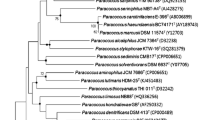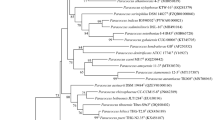Abstract
A Gram-stain-negative and facultatively aerobic bacterium, designated as strain CBA4604T, was isolated from a traditional Korean salted and fermented shrimp food (saeu-jeot). Phylogenetic analysis based on 16S rRNA gene sequences showed that strain CBA4604T formed a clearly distinct phyletic lineage from closely related species within the genus Paracoccus. Strain CBA4604T was the most closely related to P. koreensis Ch05T (97.5% 16S rRNA gene sequence similarity) and other type strains (≤ 97.0%). The genome comprised a chromosome and two plasmids of 3,299,166 bp with 66.5% G+C content. The DNA-DNA relatedness values between strain CBA4604T and P. koreensis Ch05T, P. alcaliphilus DSM 8512T, and P. stylophorae KTW-16T were 30.5%, 22.9%, and 16.7%, respectively. Cells of the strain were short rod-shaped and oxidase- and catalase-positive. The growth of strain CBA-4604T was observed at 10–40°C (optimum, 37°C), pH 6.0–10.0 (optimum, pH 7.0), and in the presence of 0–8.0% (w/v) NaCl (optimum, 0–2.0%). Strain CBA4604T contained ubiquinone 10 as the sole isoprenoid quinone and summed feature 8 (C18:1ω7c/C18:1ω6c) and C18:0 as the major cellular fatty acids. The polar lipids consisted of phosphatidylcholine, phosphatidylglycerol, diphosphatidylglycerol, phospholipid, an unidentified aminolipid, an unidentified glycolipid, and three unidentified lipids. Based on its phylogenetic, genomic, phenotypic, and chemotaxonomic features, we concluded that strain CBA-4604T represents a novel species in the genus Paracoccus and we propose the name Paracoccus jeotgali sp. nov. The type strain is CBA4604T (= KACC 19579T = JCM 32510T)
Similar content being viewed by others
References
Chin, C.S., Alexander, D.H., Marks, P., Klammer, A.A., Drake, J., Heiner, C., Clum, A., Copeland, A., Huddleston, J., Eichler, E.E., et al. 2013. Nonhybrid, finished microbial genome assemblies from long-read SMRT sequencing data. Nat. Methods 10, 563–569.
Collins, M.D. 1985. 11 Analysis of isoprenoid quinones. Methods Microbiol. 18, 329–366.
Dastager, S.G., Deepa, C.K., Li, W.J., Tang, S.K., and Pandey, A. 2011. Paracoccus niistensis sp. nov., isolated from forest soil, India. Antonie van Leeuwenhoek 99, 501–506.
Davis, D.H., Doudoroff, M., Stanier, R.Y., and Mandel, M. 1969. Proposal to reject the genus Hydrogenomonas: taxonomic implications. Int. J. Syst. Evol. Microbiol. 19, 375–390.
Ezaki, T., Hasimoto, Y., and Yabuuchi, E. 1989. Fluorometric deoxyribonucleic acid-deoxyribonucleic acid hybridization in microdilution wells as an alternative to membrane filter hybridization in which radioisotopes are used to determine genetic relatedness among bacterial strains. Int. J. Syst. Evol. Microbiol. 39, 224–229.
Gomori, G. 1955. Preparation of buffers for use in enzyme studies. Methods Enzymol. 1, 138–146.
Kampfer, P., Lai, W.A., Arun, A.B., Young, C.C., Rekha, P.D., Martin, K., Busse, H.J., and Chen, W.M. 2012. Paracoccus rhizosphaerae sp. nov., isolated from the rhizosphere of the plant Crossostephium chinense (L.) Makino (Seremban). Int. J. Syst. Evol. Microbiol. 62, 2750–2756.
Kim, K.W. 2017. Electron microscopic observations of prokaryotic surface appendages. J. Microbiol. 55, 919–926.
Kim, Y.O., Park, I.S., Park, S., Nam, B.H., Kim, D.G., Won, S.M., and Yoon, J.H. 2018. Paracoccus alimentarius sp. nov., isolated from a Korean foodstuff, salted pollack. Int. J. Syst. Evol. Microbiol. 68, 1238–1243.
Kumar, S., Stecher, G., and Tamura, K. 2016. MEGA7: Molecular evolutionary genetics analysis version 7.0 for bigger datasets. Mol. Biol. Evol. 33, 1870–1874.
La, H.J., Im, W.T., Ten, L.N., Kang, M.S., Shin, D.Y., and Lee, S.T. 2005. Paracoccus koreensis sp. nov., isolated from anaerobic granules in an upflow anaerobic sludge blanket (UASB) reactor. Int. J. Syst. Evol. Microbiol. 55, 1657–1660.
Lagesen, K., Hallin, P., Rodland, E.A., Staerfeldt, H.H., Rognes, T., and Ussery, D.W. 2007. RNAmmer: consistent and rapid annotation of ribosomal RNA genes. Nucleic Acids Res. 35, 3100–3108.
Lane, D.J. 1991. 16S/23S rRNA sequencing. John Wiley & Sons, New York, USA.
Lee, S.H., Jung, J.Y., and Jeon, C.O. 2014a. Effects of temperature on microbial succession and metabolite change during saeu-jeot fermentation. Food Microbiol. 38, 16–25.
Lee, S.H., Jung, J.Y., and Jeon, C.O. 2014b. Microbial successions and metabolite changes during fermentation of salted shrimp (saeujeot) with different salt concentrations. PLoS One 9, e90115.
Lee, M.J. and Lee, S.S. 2013. Paracoccus limosus sp. nov., isolated from activated sludge in a sewage treatment plant. Int. J. Syst. Evol. Microbiol. 63, 1311–1316.
Lee, M., Woo, S.G., Park, G., and Kim, M.K. 2011a. Paracoccus caeni sp. nov., isolated from sludge. Int. J. Syst. Evol. Microbiol. 61, 1968–1972.
Lee, J.H., Yi, H., and Chun, J. 2011b. rRNASelector: a computer program for selecting ribosomal RNA encoding sequences from metagenomic and metatranscriptomic shotgun libraries. J. Microbiol. 49, 689.
Lin, P., Yan, Z.F., Won, K.H., Yang, J.E., Li, C.T., Kook, M., Wang, Q.J., and Yi, T.H. 2017. Paracoccus hibiscisoli sp. nov., isolated from the rhizosphere of Mugunghwa (Hibiscus syriacus). Int. J. Syst. Evol. Microbiol. 67, 2452–2458.
Liu, X.Y., Wang, B.J., Jiang, C.Y., and Liu, S.J. 2006. Paracoccus sulfuroxidans sp. nov., a sulfur oxidizer from activated sludge. Int. J. Syst. Evol. Microbiol. 56, 2693–2695.
Liu, Y., Xie, Q.Y., Hong, K., Li, L., Zhao, Y.M., Tang, Y.L., An, J.Y., Zhu, P.P., and Xu, C.H. 2013. Paracoccus siganidrum sp. nov., isolated from fish gastrointestinal tract. Antonie van Leeuwenhoek 103, 1133–1139.
Medina, P. and Baresi, L. 2007. Rapid identification of gelatin and casein hydrolysis using TCA. J. Microbiol. Methods 69, 391–393.
Minnikin, D., O’donnell, A., Goodfellow, M., Alderson, G., Athalye, M., Schaal, A., and Parlett, J. 1984. An integrated procedure for the extraction of bacterial isoprenoid quinones and polar lipids. J. Microbiol. Methods 2, 233–241.
Minnikin, D., Patel, P., Alshamaony, L., and Goodfellow, M. 1977. Polar lipid composition in the classification of Nocardia and related bacteria. Int. J. Syst. Evol. Microbiol. 27, 104–117.
Nakamura, A. 2015. Paracoccus laeviglucosivorans sp. nov., an l-glucose-utilizing bacterium isolated from soil. Int. J. Syst. Evol. Microbiol. 65, 3878–3884.
Nawrocki, E.P. and Eddy, S.R. 2007. Query-dependent banding (QDB) for faster RNA similarity searches. PLoS Comput. Biol. 3, e56.
Pruitt, K.D., Tatusova, T., Klimke, W., and Maglott, D.R. 2009. NCBI reference sequences: current status, policy and new initiatives. Nucleic Acids Res. 37, D32–D36.
Roh, S.W., Nam, Y.D., Chang, H.W., Kim, K.H., Kim, M.S., Shin, K.S., Yoon, J.H., Oh, H.M., and Bae, J.W. 2009. Paracoccus aestuarii sp. nov., isolated from tidal flat sediment. Int. J. Syst. Evol. Microbiol. 59, 790–794.
Sasser, M. 1990. Identification of bacteria by gas chromatography of cellular fatty acids. MIDI. Technical Note #101.
Sheu, S.Y., Hsieh, T.Y., Young, C.C., and Chen, W.M. 2018. Paracoccus fontiphilus sp. nov., isolated from a freshwater spring. Int. J. Syst. Evol. Microbiol. 68, 2054–2060.
Sheu, S.Y., Jiang, S.R., Chen, C.A., Wang, J.T., and Chen, W.M. 2011. Paracoccus stylophorae sp. nov., isolated from the reef-building coral Stylophora pistillata. Int. J. Syst. Evol. Microbiol. 61, 2221–2226.
Sierra, G. 1957. A simple method for the detection of lipolytic activity of micro-organisms and some observations on the influence of the contact between cells and fatty substrates. Antonie van Leeuwenhoek 23, 15–22.
Singh, A.K., Kohli, P., Mahato, N.K., and Lal, R. 2017. Paracoccus sordidisoli sp. nov., isolated from an agricultural field contaminated with hexachlorocyclohexane isomers. Int. J. Syst. Evol. Microbiol. 67, 4365–4371.
Smibert, R.M. 1994. Phenotypic characterization. In Methods for general and molecular bacteriology, American Society for Microbiology.
Sun, L.N., Zhang, J., Kwon, S.W., He, J., Zhou, S.G., and Li, S.P. 2013. Paracoccus huijuniae sp. nov., an amide pesticide-degrading bacterium isolated from activated sludge of a wastewater biotreatment system. Int. J. Syst. Evol. Microbiol. 63, 1132–1137.
Urakami, T., Tamaoka, J., Suzuki, K.I., and Komagata, K. 1989. Paracoccus alcaliphilus sp. nov., an alkaliphilic and facultatively methylotrophic bacterium. Int. J. Syst. Evol. Microbiol. 39, 116–121.
Wayne, L., Brenner, D., Colwell, R., Grimont, P., Kandler, O., Krichevsky, M., Moore, L., Moore, W., Murray, R., and Stackebrandt, E. 1987. Report of the ad hoc committee on reconciliation of approaches to bacterial systematics. Int. J. Syst. Evol. Microbiol. 37, 463–464.
Wheater, D.M. 1955. The characteristics of Lactobacillus acidophilus and Lactobacillus bulgaricus. Microbiology 12, 123–132.
Wu, Z.G., Zhang, D.F., Liu, Y.L., Wang, F., Jiang, X., Li, C., Li, S.P., Hong, Q., and Li, W.J. 2013. Paracoccus zhejiangensis sp. nov., isolated from activated sludge in wastewater-treatment system. Antonie van Leeuwenhoek 104, 123–128.
Xue, H., Piao, C.G., Guo, M.W., Wang, L.F., and Li, Y. 2017. Paracoccus aerius sp. nov., isolated from air. Int. J. Syst. Evol. Microbiol. 67, 2586–2591.
Yan, Z.F., Moya, G., Lin, P., Won, K.H., Yang, J.E., Li, C.T., Kook, M., Wang, Q.J., and Yi, T.H. 2017. Paracoccus hibisci sp. nov., isolated from the rhizosphere of Hibiscus syriacus L. (Mugunghwa flower). Int. J. Syst. Evol. Microbiol. 67, 1849–1854.
Yoon, S.H., Ha, S.M., Kwon, S., Lim, J., Kim, Y., Seo, H., and Chun, J. 2017. Introducing EzBioCloud: a taxonomically united database of 16S rRNA gene sequences and whole-genome assemblies. Int. J. Syst. Evol. Microbiol. 67, 1613–1617.
Author information
Authors and Affiliations
Corresponding authors
Additional information
Supplemental material for this article may be found at http://www.springerlink.com/content/120956.
Electronic supplementary material
Rights and permissions
About this article
Cite this article
Kim, J., Kim, J.Y., Song, H.S. et al. Paracoccus jeotgali sp. nov., isolated from Korean salted and fermented shrimp. J Microbiol. 57, 444–449 (2019). https://doi.org/10.1007/s12275-019-8704-8
Received:
Revised:
Accepted:
Published:
Issue Date:
DOI: https://doi.org/10.1007/s12275-019-8704-8




